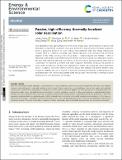Passive, high-efficiency thermally-localized solar desalination
Author(s)
Zhang, Lenan; Xu, Zhenyuan; Zhao, Lin; Bhatia, Bikram; Zhong, Yang; Gong, Shuai; Wang, Evelyn; ... Show more Show less
Downloadd0ee03991h.pdf (68.70Mb)
Publisher with Creative Commons License
Publisher with Creative Commons License
Creative Commons Attribution
Terms of use
Metadata
Show full item recordAbstract
Solar desalination holds significant promise for the water-energy nexus. Recent advances in passive solar desalination using thermal localization show great potential for high-efficiency freshwater production, which is particularly beneficial for areas without well-established water and energy infrastructure. However, there is a significant knowledge gap between laboratory scale innovation and commercial adoption. In this review, we discuss two critical factors – water production and reliability – which, if addressed systematically, could enable high-performance thermally-localized solar desalination systems. We show that optimizing heat and mass transfer of the entire device and recycling the latent heat of condensation are important to enhance total water production. Meanwhile, we discuss the potential of novel system architectures and fluid flow engineering to enable anti-fouling and robust desalination devices. In addition, we present techno-economic analysis that highlights the balance between water production, reliability, and cost. A criterion for economic feasibility is provided by comparing the price of desalinated water with commercially available bottle and tap water, which provides a roadmap for future development of solar desalination technologies.
Date issued
2021-03Department
Massachusetts Institute of Technology. Department of Mechanical EngineeringJournal
Energy & Environmental Science
Publisher
Royal Society of Chemistry (RSC)
Citation
Zhang, Lenan. "Passive, high-efficiency thermally-localized solar desalination." Energy & Environmental Science 14, 4 (March 2021): 1771-1793. © 2021 The Royal Society of Chemistry
Version: Final published version
ISSN
1754-5692
1754-5706